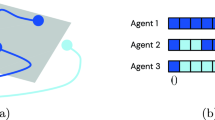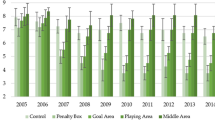Abstract
Visual processing involves numerous neuro-ophthalmic pathways that enable humans to perceive and interact with the world. These visual pathways can negatively impact visual perception and decision-making. The Vestibulo-Ocular Reflex (VOR) is a compensatory mechanism that stabilizes gaze on a target during head movement, such as running or turning. However, inadequate VOR stabilization can lead to retinal slip, reducing visual acuity. In the National Football League (NFL), officials require exceptional visual training and performance. NFL officiating utilize rapid visual processing, strategic movements, and precise judgement to make accurate penalty calls in real-time. Retinal slip can adversely affect play calling and penalty assessment by NFL officials. Despite these challenges, NFL officials achieve high precision and accuracy in up to 98.9% of plays. To maintain such high standards, the NFL has implemented a standardized curriculum to mitigate the effects of VOR and retinal slip. This manuscript outlines the basics of VOR function and explores countermeasures to minimize retinal slip in NFL officiating. We believe that these scientific endeavours can improve both penalty assessment accuracy and precision. The use of these general principles might also be potentially applicable to other sports.
This is a preview of subscription content, access via your institution
Access options
Subscribe to this journal
Receive 18 print issues and online access
$259.00 per year
only $14.39 per issue
Buy this article
- Purchase on SpringerLink
- Instant access to full article PDF
Prices may be subject to local taxes which are calculated during checkout




Similar content being viewed by others
Data availability
No new data were created or analysed in this study. Data sharing is not applicable to this article.
References
NFL Officials: Preparing for Success. NFL Operations. https://operations.nfl.com/officiating/nfl-officials-preparing-for-success/. Accessed 16 May 2024.
Vogt AZ, Woodland MB, Carter MJ, Lee AG. Curriculum in neuro-ophthalmic principles for National Football League Game Officials: comparison of pretraining and posttraining ratings of knowledge. J Neuro-Ophthalmol. https://doi.org/10.1097/WNO.0000000000001926.
Dieterich M, Müller-Schunk S, Stephan T, Bense S, Seelos K, Yousry TA. Functional magnetic resonance imaging activations of cortical eye fields during saccades, smooth pursuit, and optokinetic nystagmus. Ann NY Acad Sci. 2009;1164:282–92. https://doi.org/10.1111/j.1749-6632.2008.03718.x.
Büttner-Ennever JA, Horn AK. Anatomical substrates of oculomotor control. Curr Opin Neurobiol. 1997;7:872–9. https://doi.org/10.1016/s0959-4388(97)80149-3.
Roy JE, Cullen KE. A neural correlate for vestibulo-ocular reflex suppression during voluntary eye–head gaze shifts. Nat Neurosci. 1998;1:404–10. https://doi.org/10.1038/1619.
Iwashita M, Kanai R, Funabiki K, Matsuda K, Hirano T. Dynamic properties, interactions and adaptive modifications of vestibulo-ocular reflex and optokinetic response in mice. Neurosci Res. 2001;39:299–311. https://doi.org/10.1016/s0168-0102(00)00228-5.
Fetter M. Vestibulo-ocular reflex. In: Developments in ophthalmology. Karger; 2007;40:35–51. https://doi.org/10.1159/000100348.
Wong AMF. New understanding on the contribution of the central otolithic system to eye movement and skew deviation. Eye. 2015;29:153–6. https://doi.org/10.1038/eye.2014.243.
Robinson DA. Basic framework of the vestibulo-ocular reflex. In: Progress in brain research. Vol 267. Elsevier; 2022:131-53. https://doi.org/10.1016/bs.pbr.2021.10.006.
Kushiro K, Zakir M, Sato H, Ono S, Ogawa Y, Meng H, et al. Saccular and utricular inputs to single vestibular neurons in cats. Exp Brain Res. 2000;131:406–15. https://doi.org/10.1007/s002219900312.
Chen G, Zhang J, Qiao Q, Zhou L, Li Y, Yang J, et al. Advances in dynamic visual acuity test research. Front Neurol. 2023;13:1047876. https://doi.org/10.3389/fneur.2022.1047876.
Leigh RJ, Averbuch‐Heller L, Tomsak RL, Remler BF, Yaniglos SS, Dell’Osso LF. Treatment of abnormal eye movements that impair vision: strategies based on current concepts of physiology and pharmacology. Ann Neurol. 1994;36:129–41. https://doi.org/10.1002/ana.410360204.
Gauthier GM, Robinson DA. Adaptation of the human vestibuloocular reflex to magnifying lenses. Brain Res. 1975;92:331–5. https://doi.org/10.1016/0006-8993(75)90279-6.
Land MF. Motion and vision: why animals move their eyes. J Comp Physiol A. 1999;185:341–52. https://doi.org/10.1007/s003590050393.
Ramaioli C, Cuturi LF, Ramat S, Lehnen N, MacNeilage PR. Vestibulo-ocular responses and dynamic visual acuity during horizontal rotation and translation. Front Neurol. 2019;10:321. https://doi.org/10.3389/fneur.2019.00321.
Mahfuz MM, Schubert MC, Figtree WVC, Migliaccio AA. Retinal image slip must pass the threshold for human vestibulo-ocular reflex adaptation. JARO. 2020;21:277–85. https://doi.org/10.1007/s10162-020-00751-6.
Herdman SJ. Vestibular rehabilitation. Curr Opin Neurol. 2013;26:96–101. https://doi.org/10.1097/WCO.0b013e32835c5ec4.
Verbecque E, Van Criekinge T, Vanloot D, Coeckelbergh T, Van de Heyning P, Hallemans A, et al. Dynamic visual acuity test while walking or running on treadmill: reliability and normative data. Gait Posture. 2018;65:137–42. https://doi.org/10.1016/j.gaitpost.2018.07.166.
Ishigaki H, Miyao M. Differences in dynamic visual acuity between athletes and nonathletes. Percept Mot Skills. 1993;77:835–9. https://doi.org/10.2466/pms.1993.77.3.835.
Bhabhor MK, Vidja K, Bhanderi P, Dodhia S, Kathrotia R, Joshi V. A comparative study of visual reaction time in table tennis players and healthy controls. Indian J Physiol Pharm. 2013;57:439–42.
Laby DM, Kirschen DG, Pantall P. The visual function of olympic-level athletes—an initial report. Eye Contact Lens Sci Clin Pract. 2011;37:116–22. https://doi.org/10.1097/ICL.0b013e31820c5002.
Jorge J, Fernandes P. Static and dynamic visual acuity and refractive errors in elite football players. Clin Exp Optom. 2019;102:51–6. https://doi.org/10.1111/cxo.12812.
Kızılay F, Cengiz DU. A comparison of functional vestibulo-ocular reflex and proprioception in athletes of combat sports and ball sports. Heliyon. 2023;9:e17540. https://doi.org/10.1016/j.heliyon.2023.e17540.
Baptista AMG, Serra PM, Faisal M, Barrett BT. Association between clinical vision measures and visual perception and soccer referees’ on-field performance. Optom Vis Sci. 2021;98:789–801. https://doi.org/10.1097/OPX.0000000000001722.
Eric Fisher. NFL caps dominate regular season (Again), this time up 7% in ratings. Front Office Sports. 2024. https://frontofficesports.com/nfl-caps-dominate-regular-season-again-this-time-up-7-in-ratings/#:~:text=The%20NFL%20concluded%20its%202023,NFL’s%20best%20figure%20since%202015.
Carrabba NV, Ong J, Vogt AZ, et al. National Football League game officials self-rating of knowledge in neuro-ophthalmic principles and practice: a pilot program to improve precision and accuracy of game official calls. J Neuro-Ophthalmol. 2024. https://doi.org/10.1097/WNO.0000000000002129.
Lee A, Zapletal A, Woodland B, Carter M. Pigskins and perception: how neuro-ophthalmology influences NFL referees. Ophthalmol Times. 2022. https://www.ophthalmologytimes.com/view/pigskins-and-perception-how-neuro-ophthalmology-influences-nfl-referees. Accessed 16 May 2024.
Gonshor A, Jones GM. Short‐term adaptive changes in the human vestibulo‐ocular reflex arc. J Physiol. 1976;256:361–79. https://doi.org/10.1113/jphysiol.1976.sp011329.
Fadaee SB, Migliaccio AA. The effect of retinal image error update rate on human vestibulo-ocular reflex gain adaptation. Exp Brain Res. 2016;234:1085–94. https://doi.org/10.1007/s00221-015-4535-y.
Mahfuz MM, Schubert MC, Figtree WVC, Todd CJ, Migliaccio AA. Human vestibulo-ocular reflex adaptation: consolidation time between repeated training blocks improves retention. JARO. 2018;19:601–10. https://doi.org/10.1007/s10162-018-00686-z.
Ong J, Carrabba NV, Waisberg E, Zaman N, Memon H, Panzo N, et al. Dynamic visual acuity, vestibulo-ocular reflex, and visual field in National Football League (NFL) officiating: physiology and visualization engineering for 3D virtual on-field training. Vision. 2024;8:35. https://doi.org/10.3390/vision8020035.
Richlan F, Weiß M, Kastner P, Braid J. Virtual training, real effects: a narrative review on sports performance enhancement through interventions in virtual reality. Front Psychol. 2023;14:1240790. https://doi.org/10.3389/fpsyg.2023.1240790.
Zaman N, Ong J, Waisberg E, Masalkhi M, Lee AG, Tavakkoli A, et al. Advanced visualization engineering for vision disorders: a clinically focused guide to current technology and future applications. Ann Biomed Eng. 2023. https://doi.org/10.1007/s10439-023-03379-8.
Ong CW, Tan MCJ, Lam M, Koh VTC. Applications of extended reality in ophthalmology: systematic review. J Med Internet Res. 2021;23:e24152. https://doi.org/10.2196/24152.
Author information
Authors and Affiliations
Contributions
Conceptualization, JO and AGL, investigation, JO, NP, HM, and AGL; writing—original draft preparation, JO, NP, and HM, writing—review and editing, JO, NP, HM, NC, NZ, VL, AZ, NL, AT, EW, PS, and AGL; supervision, AGL; project administration, NP; All authors have read and agreed to the published version of the manuscript.
Corresponding author
Ethics declarations
Competing interests
AGL serves as a consultant for the National Football League (NFL). Dr. Lee is on the Speakers’ Bureau for Amgen and Alexion and is on the Advisory Board for Viridian and Stoke and serves as a consultant for Bristol Myers Squibb and Astrazeneca. Dr. Lee serves on the Editorial board of Eye.
Additional information
Publisher’s note Springer Nature remains neutral with regard to jurisdictional claims in published maps and institutional affiliations.
Supplementary information
Rights and permissions
Springer Nature or its licensor (e.g. a society or other partner) holds exclusive rights to this article under a publishing agreement with the author(s) or other rightsholder(s); author self-archiving of the accepted manuscript version of this article is solely governed by the terms of such publishing agreement and applicable law.
About this article
Cite this article
Panzo, N., Ong, J., Memon, H. et al. The potential role of retinal slip in National Football League (NFL) officiating and its effect on on-field decision making: mechanisms and countermeasures. Eye 39, 478–483 (2025). https://doi.org/10.1038/s41433-024-03533-z
Received:
Revised:
Accepted:
Published:
Issue date:
DOI: https://doi.org/10.1038/s41433-024-03533-z



